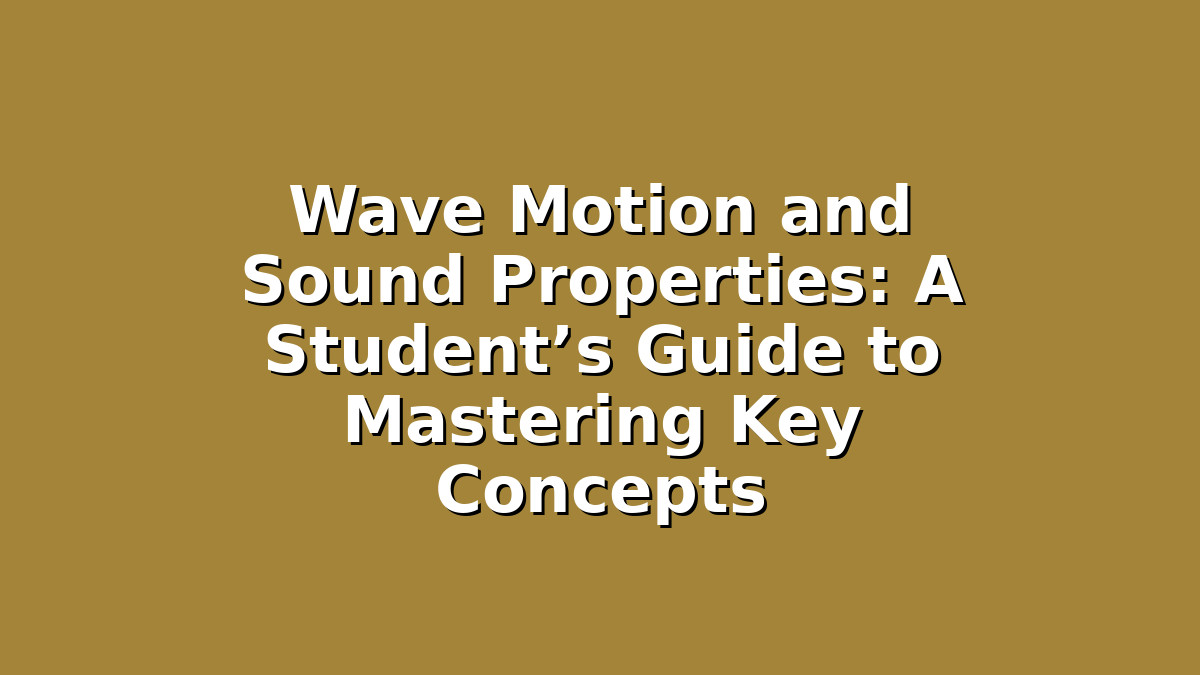When preparing for exams, especially in physics, understanding wave motion and sound properties can sometimes feel overwhelming. These topics are fundamental to many scientific principles and appear frequently in test questions. But don’t worry! With the right approach and study strategies, you can grasp these concepts confidently and improve your exam performance. In this guide, we’ll break down wave motion and sound properties into easy-to-understand sections and provide helpful study tips tailored for students like you.
Understanding Wave Motion: The Basics and Beyond
Wave motion is the transfer of energy from one point to another without the physical transfer of matter. This concept is essential because waves are everywhere—light waves, sound waves, water waves, and even seismic waves during an earthquake.
Key Concepts to Focus On:
– Types of Waves: Mechanical waves (which need a medium such as air, water, or solids) and electromagnetic waves (which can travel through a vacuum).
– Wave Parameters: Wavelength (distance between two crests or troughs), frequency (number of waves passing a point per second), amplitude (height of the wave), and speed.
– Wave Behavior: Reflection, refraction, diffraction, and interference.
Study Tips:
1. Visual Learning: Use diagrams and animations to visualize wave motion. Many online platforms offer interactive simulations where you can change wave parameters and see their effects in real time.
2. Create Summary Charts: Make a chart that lists different wave types with their characteristics and examples. This visual tool can help you quickly recall distinctions during exams.
3. Practice Problems: Apply formulas such as ( v = f lambda ) (wave speed = frequency × wavelength) to various scenarios. The more problems you solve, the better you’ll understand how these variables interact.
Exploring Sound Properties: What Makes Sound Work?
Sound is a type of mechanical wave that travels through a medium by vibrating particles. Understanding sound’s properties helps explain everyday phenomena like why sounds change pitch or get louder.
Core Properties to Master:
– Pitch: Determined by frequency. Higher frequency means higher pitch.
– Loudness: Related to amplitude and energy of the wave.
– Speed of Sound: Affected by the medium (faster in solids, slower in gases).
– Echo and Reverberation: Reflection of sound waves that help in locating objects or affect acoustics.
– Doppler Effect: Change in frequency or pitch due to relative motion between the source and the observer.
Study Tips:
1. Relate to Real Life: Think about everyday examples like sirens, musical instruments, or echoes. Relating abstract concepts to familiar experiences makes it easier to remember.
2. Use Mnemonics: For instance, to remember the factors affecting sound speed, use a simple mnemonic like “SoliD Is Fast” (Solids > Liquids > Gases in speed).
3. Listen and Analyze: If possible, experiment with sound using apps or recording devices, noting pitch changes or echoes. Engaging multiple senses reinforces learning.
Applying Your Knowledge: Exam Strategies and Time Management
Knowing the theory is just part of the battle. Effectively demonstrating your knowledge during exams requires practice and good study habits.
Effective Exam Preparation Tips:
– Active Recall: Instead of just reading notes, try to recite definitions, explain concepts aloud, or teach them to a friend. This technique improves memory retention.
– Practice Past Papers: Look for previous exam questions on wave motion and sound properties. Time yourself and simulate exam conditions to build confidence.
– Mind Maps and Flashcards: Create mind maps linking different wave and sound concepts. Flashcards with questions on one side and answers on the back can help you review quickly anytime.
– Group Study: Discuss tricky topics with classmates. Teaching others or debating concepts can reveal gaps in your understanding and solidify your knowledge.
– Break Study Sessions: Use the Pomodoro technique — study intensely for 25 minutes, then take a 5-minute break. It keeps your mind fresh and focused.
Conclusion: Your Path to Success with Wave Motion and Sound
Wave motion and sound properties are fascinating topics that connect physics to the world around you. With consistent study, visualization, practical examples, and strategic exam preparation, you can master these areas and boost your confidence in physics exams.
Remember, understanding takes time and repeated effort. Don’t hesitate to ask teachers for clarification or use online resources to supplement your learning. Stay positive, keep practicing, and celebrate your progress along the way. You’ve got this!

Responses